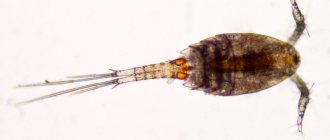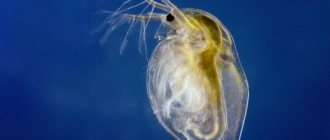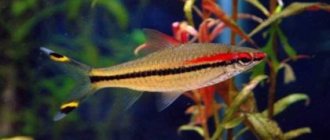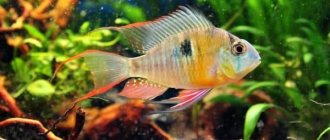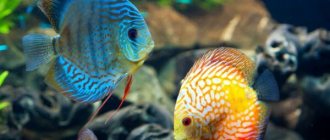What does a person imagine when he hears a word? "Cyclops"? As a rule, there are two options: if he is far from biology and aquariums, then, most likely, he will decide that we are talking about the mythical one-eyed giant who threw stones at the ships of Odysseus. If the subject in question has an aquarium or carefully read biology at school, then for him the Cyclops, first of all, will look like a tiny crustacean, upon closer examination, much more mysterious and terrible than the mythical giant.
Several times I came across cyclops while studying silt from an aquarium, however, these crustaceans are rare guests in an aquarium. The real dominance of cyclops was discovered in water from stagnant shallow waters. These crustaceans stood out among the other zooplankton swarming in the bowl with their striking bright green (almost fluorescent) color. What they ate to achieve such an effect remains a mystery to us.
Who are the Cyclops?
Well, firstly , this is a popular fish food, along with daphnia and gammarus, but this aspect of their life (or rather, death) is of little interest, so we will not dwell on it.
Cyclops (Cyclops coronatus) in reflected light
Secondly , these are small (0.6-6 mm) crustaceans belonging to the order copepods.
Symmetry of the living at the embryonic stage
Ancient scientists, who were strong in geometry and mathematics in general, loved to speculate about the geometry of living things and argued very much about this, especially about where symmetry, essentially an abstract concept in science, came from in nature, and, okay, in inanimate things nature, but also in living things! They could only build speculative theories to explain this; they had no facts to support them. Facts appeared only in modern times, when Leeuwenhoek invented the microscope, Baron Cuvier added long-extinct species to the comparative anatomy of animals, Schleiden and Schwann substantiated the postulate of the cellular structure of all living organisms, Haeckel and Müller formulated the biogenetic law, and Darwin the general principles of evolution.
The Haeckel-Müller law immediately after its publication was criticized by their colleagues, and the further, the more scientists found in it inconsistencies with the principle stated in it. Things got to the point where there were calls to consider it erroneous. But it would be unscientific to expect that the embryo of, for example, a chicken in an egg would repeat in accuracy and detail the entire evolutionary path of birds, and that, breaking the egg ahead of schedule, we would find a pterodactyl in it. Indeed, in Haeckel’s formulation of the law it is clearly and clearly stated: “Ontogenesis is a quick and brief repetition of phylogeny.” Today, any expectant mother sees the main stages of mammalian phylogenesis in ultrasound pictures as a matter of course.
At the blastula stage, that is, a lump of several dozen cells, the embryo can hardly be called symmetrical, but when it becomes like a worm, then it is already a creature with a front and a back side, with a left and right side. The future person at this stage of his individual development (ontogenesis) is already symmetrical, the shape of the left half mirrors the right, and vice versa. Then a pair of arms and legs will appear, one on each side, and when a person is born and opens his eyes, he will look at the world with two eyes.
The puzzle of living symmetry finally came together towards the end of the 19th century. Simple explanations have been found for the change in the structural plans of living beings (and, accordingly, the appearance and change of their types of symmetry) from the moment of the emergence of life on Earth to the present day. Like classical Newtonian physics, biology has developed a coherent and logical picture of the world within the framework of the paradigm of Darwinism and the recapitulation of phylogeny in ontogenesis. Biological scientists, enthusiastically arguing with each other about minor details, lived well in it for a hundred years, until quite recently, at the end of the last, twentieth century, they finally fell into the heresy of relativism of molecular biology.
Classification of Cyclops
Not everything is clear with the classification of Cyclops. So, according to Wikipedia it looks like this:
- Type: Arthropods
- Subtype: Crustaceans
- Class: Jawfish
- Subclass: Copepods
- Squad: Cyclops
- Family: Cyclops
That is, here, shaking the foundations of my worldview, crustaceans are not a class, but a subtype. Copepods are classified as a subclass of Cenopods . In general, perhaps it is more correct and more modern, but for simple amateurs who do not go into the taxonomic jungle, it is easier to rely on the old classification (TSB), so at least there is a chance to remember:
- Phylum: Arthropoda (Arthropoda)
- Class: Crustaceans (Crustacea)
- Order: Copepoda (Copepoda)
- Family: Cyclops (Cyclopidae)
- Genus: Cyclops
- Species: Cyclops coronatus
Two symmetries
There is no need to walk around the tree to make sure that it is a tree and not something else. Even a shapeless bush will not evoke such a desire. Why look at it from all sides: a bush - it is a bush. The plant has a trunk from which branches with leaves, flowers or needles extend in all directions. It is clear that this is the most general plan of plant structure, which has a lot of exceptions, but these exceptions are secondary, and the highest, that is, the most general type of symmetry for a plant is radial, that is, it is symmetrical around one axis of symmetry - the trunk.
If we meet a person, then we do not stand with our backs to him: firstly, it is impolite, and secondly, our eyes are not on the back, but in front. From the point of view of comparative anatomy, we have an anterior (abdominal) and posterior (dorsal) side, they are asymmetrical to each other. But if you look from the front or back, then the right and left halves of our body are identical from the outside, only they are mirrored relative to the plane dividing the body into left and right halves.
The vast majority of modern animals have the same geometry, from flatworms and insects to mammals. If you look at any of them from the front or back, the picture is different, that is, the front and rear ends are asymmetrical. But everyone necessarily has a ventral and a dorsal side, and a right and a left side. Such symmetry relative to a plane perpendicular to the plane dividing the body into ventral and dorsal sides is called bilateral, or scientifically bilateral.
The structure of the Cyclops
“Cyclops” came from - our hero has only one eye, but he has enough.
Friends! This is not just an advertisement, but my, the author of this site, personal request. Please join the ZooBot group on VK. This is pleasant for me and useful for you: there will be a lot there that will not end up on the site in the form of articles.
Cyclops (Cyclops coronatus) in reflected light
The body of the Cyclops is divided into a cephalothorax and abdomen. In front there are two pairs of branched antennae (of course, not nearly as branched as those of daphnia). On the underside of the abdomen there are 4 pairs of developed rowing legs. The fifth pair in males is transformed into a special grip for holding the female during mating. The female has paired egg sacs on the sides of her abdomen.
Cyclops (Cyclops coronatus) in reflected light
Compared to Daphnia, the internal structure of the Cyclops looks simplified. It has neither a heart nor gills. There is no circulatory system: the organs are washed by hemolymph, moving due to the pulsation of the intestines. Absorption of oxygen from water occurs over the entire surface of the body.
Unlike Daphnia, Cyclops reproduce sexually . Most sources say that parthenogenesis is not observed in copepods.
Reproduction and larvae
To determine the sex of a cyclops crustacean, just look at it under a magnifying glass: females have a small pouch at the end of their body. These crustaceans reproduce at a high speed, which helps maintain the population and survive even in small vessels and aquariums. They are able to colonize the body of water they find themselves in in a short period of time.
Cyclops larvae, called nauplii, are born in the very sacs at the end of the female’s body that allow the sex of the individual to be determined. There can be a different number of egg sacs - from one to three. The larvae fully grow in them, but differ quite significantly from the adult. After bearing the offspring (usually 10 to 12 eggs), the female sheds the bags because they have stretched. Later she grows new ones.
Cyclops larvae, called nauplii
In natural conditions, it is quite difficult for fish to catch both larvae and adults, because they are very mobile. For this reason, aquarium fish should be given a very small amount of crustaceans, otherwise the uncaught ones will multiply, fill the aquarium and eat the fry themselves.
Cyclops habitats
Cyclops (Cyclops coronatus)
Cyclops are ubiquitous and have proven themselves to be one of the most hardcore survivalists. They live in winter reservoirs under a crust of ice, in acidic and hot springs, in waters with an insignificant oxygen content and lethal amounts of hydrogen sulfide, in general, almost everywhere.
When a body of water freezes through or dries out, cyclops “preserve” themselves by secreting a special substance that forms a kind of cocoon around the crustacean. In such a cocoon, Cyclops can freeze into ice or remain at the bottom of a dry puddle. Experiments were carried out in which cyclops were preserved in dry silt, which had lain without water for three years.
By nature of feeding, Cyclops is a predator. It feeds on protozoa, rotifers, small crustaceans, in general, on everything it can catch.
Cyclops can be intermediate hosts of parasitic worms (guinea worm, tapeworm and others).
Description of the species
Often all crustaceans of this family are called cyclops, although this is incorrect. Each individual species has its own unique structure. The largest cyclops reach 4.5 mm in length; although exceptions do occur, they are very rare. Typically, the growth of crustaceans is from 0.5 to 2 mm. They are divided into females and males, whose sexual characteristics are well expressed and noticeable upon closer examination. Their color may vary depending on the food eaten, although the most common colors are:
- grey;
- red;
- green.
Cyclops are predatory microorganisms
Despite their tiny size, cyclops are predators . They make a sudden dash to catch an unsuspecting victim by surprise. If for some reason it was not possible to catch anyone, then the crustaceans feed on algae. Since they themselves are food for the inhabitants of fresh water bodies, it happens that through them fish and humans are infected with parasites (through the consumption of infected fish).
Most often, crustaceans live in the coastal waters of lakes and rivers. Sometimes they can be found in puddles of melted snow.
Evolution of symmetry
In the most general terms, the classical history of the symmetry of living things arose and changed like this. The first organisms on the planet that arose in the ocean were single-celled lumps, and there was not even a hint of symmetry here. The common hypothetical ancestor of all multicellular organisms was a colony of unicellular organisms in the form of a ball. Scientists have not yet found the original fossil due to its delicate physique, but there is a living analogue of it - the green algae Volvox.
It has the shape of a hollow ball, the walls of which consist of identical unicellular algae. Each of them is connected to its nearest neighbors by threads of its own and neighboring protoplasm, that is, they do not just hold hands with each other, but have already grown together into a single whole. They each feed on their own. But there are already specialized cells dedicated to reproduction; the rest, to put it simply, do not care about the sexual issue.
Then a dent formed in the ball from the cells, which grew, and as a result the ball turned out to be a hemisphere hollow inside, like half a walnut shell. For the same reason that such organisms are so fragile, there are no fossil prototypes of them, but there are living and thriving jellyfish, which probably everyone has seen. They are a typical example of a primitive radially symmetrical animal.
In Archean times everyone was like this. Those that chose a sessile (sedentary) lifestyle anchored at the bottom and subsequently acquired the ability for photosynthesis, giving rise to plants and the general plan of their structure according to the type of radial symmetry. Those that actively searched for food gave rise to other types of animals besides the coelenterates, as scientists call the type of animal to which jellyfish belong.
The search for food by active hunters determined the two poles of their body - the anterior and posterior; in shape they no longer resemble a hollow hemisphere, but like the finger of a glove: a sausage with a mouth. Due to gravity, those that settled to the bottom acquired the ventral (ventral) and dorsal (dorsal) surfaces of the body, then the anal pore burst at the posterior end, and the job was basically done. Paleontologists find fossil remains of such animals, similar to a modern slug, in such quantities that they even created their taxonomy, and evolutionary biologists have long been building theories about who among them descended from whom.
Almost all invertebrate animals descended from them - worms, mollusks, arthropods (including insects). Then something happened, and in some, at the embryonic stage, an anus broke through in place of the primary mouth, and a secondary mouth arose at the opposite, originally anal in evolution, posterior end of the body. All vertebrates, including humans, evolved from such deuterostome organisms.
However, it’s better not to even think about it, otherwise sooner or later the thought will come to your mind about how, from the point of view of science, we kiss.
The main thing was different: once the abdominal and dorsal sides of the body arose, then, according to the laws of stereometry, the right and left sides of this body simultaneously appeared. In this case, they were mirror images of each other, because in terms of natural selection there were no prerequisites for giving preference to the left or right side. This is how bilateral, bilateral symmetry appeared, and it is characteristic of all higher animals. There are, of course, exceptions, but from the category of those that confirm the rule. Just as there are exceptions among radially symmetrical organisms.
Biologists, however, distinguish about half a dozen more types of symmetry (anaxonal, spherical, indefinitely polyaxonic, regular polyaxonic, stauraconic, monaxonal heteropolar, sliding symmetry, fractal symmetry, etc.). But if we omit single-celled protozoa, then there are only two main types of symmetry in living things on Earth: radial and bilateral. The first predominates in plants, the second in animals. This concerns the general shape of the body. Internal organs, and sometimes external ones - for example, eyes - can be located asymmetrically.

